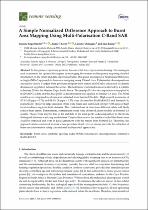 ResearchSpace
ResearchSpace
A simple normalized difference approach to burnt area mapping using multi-polarisation C-Band SAR
JavaScript is disabled for your browser. Some features of this site may not work without it.
- ResearchSpace
- →
- Research Publications/Outputs
- →
- Journal Articles
- →
- View Item
| dc.contributor.author |
Engelbrecht, Jeanine

|
|
| dc.contributor.author |
Theron, Andre

|
|
| dc.contributor.author |
Vhengani, Lufuno

|
|
| dc.contributor.author |
Kemp, J

|
|
| dc.date.accessioned | 2017-10-04T10:46:46Z | |
| dc.date.available | 2017-10-04T10:46:46Z | |
| dc.date.issued | 2017-07 | |
| dc.identifier.citation | Engelbrecht, J., Theron, A., Vhengani, L. et al. A simple normalized difference approach to burnt area mapping using multi-polarisation C-Band SAR. Remote sensing, vol. 9(8): 1-13 | en_US |
| dc.identifier.issn | 2072-4292 | |
| dc.identifier.uri | http://www.mdpi.com/2072-4292/9/8/764 | |
| dc.identifier.uri | doi:10.3390/rs9080764 | |
| dc.identifier.uri | http://hdl.handle.net/10204/9636 | |
| dc.description | Remote sensing, vol. 9(8): doi:10.3390/rs9080764 | en_US |
| dc.description.abstract | In fire-prone ecosystems, periodic fires are vital for ecosystem functioning. Fire managers seek to promote the optimal fire regime by managing fire season and frequency requiring detailed information on the extent and date of previous burns. This paper investigates a Normalised Difference a-Angle (NDaI) approach to burn-scar mapping using C-band data. Polarimetric decompositions are used to derive a-angles from pre-burn and post-burn scenes and NDaI is calculated to identify decreases in vegetation between the scenes. The technique was tested in an area affected by a wildfire in January 2016 in the Western Cape, South Africa. The quad-pol H-A-a decomposition was applied to RADARSAT-2 data and the dual-pol H-a decomposition was applied to Sentinel-1A data. The NDaI results were compared to a burn scar extracted from Sentinel-2A data. High overall accuracies of 97.4% (Kappa = 0.72) and 94.8% (Kappa = 0.57) were obtained for RADARSAT-2 and Sentinel-1A, respectively. However, large omission errors were found and correlated strongly with areas of high local incidence angle for both datasets. The combined use of data from different orbits will likely reduce these errors. Furthermore, commission errors were observed, most notably on Sentinel-1A results. These errors may be due to the inability of the dual-pol H-a decomposition to effectively distinguish between scattering mechanisms. Despite these errors, the results revealed that burnt areas could be extracted and were in good agreement with the results from Sentinel-2A. Therefore, the approach can be considered in areas where persistent cloud cover or smoke prevents the extraction of burnt area information using conventional multispectral approaches. | en_US |
| dc.language.iso | en | en_US |
| dc.publisher | MDPI AG | en_US |
| dc.relation.ispartofseries | Worklist;19550 | |
| dc.subject | Burnt area | en_US |
| dc.subject | Synthetic aperture radar (SAR) | en_US |
| dc.subject | Polarimetric decomposition | en_US |
| dc.subject | Sentinel-1 | en_US |
| dc.subject | RADARSAT-2 | en_US |
| dc.title | A simple normalized difference approach to burnt area mapping using multi-polarisation C-Band SAR | en_US |
| dc.type | Article | en_US |
| dc.identifier.apacitation | Engelbrecht, J., Theron, A., Vhengani, L., & Kemp, J. (2017). A simple normalized difference approach to burnt area mapping using multi-polarisation C-Band SAR. http://hdl.handle.net/10204/9636 | en_ZA |
| dc.identifier.chicagocitation | Engelbrecht, Jeanine, Andre Theron, Lufuno Vhengani, and J Kemp "A simple normalized difference approach to burnt area mapping using multi-polarisation C-Band SAR." (2017) http://hdl.handle.net/10204/9636 | en_ZA |
| dc.identifier.vancouvercitation | Engelbrecht J, Theron A, Vhengani L, Kemp J. A simple normalized difference approach to burnt area mapping using multi-polarisation C-Band SAR. 2017; http://hdl.handle.net/10204/9636. | en_ZA |
| dc.identifier.ris | TY - Article AU - Engelbrecht, Jeanine AU - Theron, Andre AU - Vhengani, Lufuno AU - Kemp, J AB - In fire-prone ecosystems, periodic fires are vital for ecosystem functioning. Fire managers seek to promote the optimal fire regime by managing fire season and frequency requiring detailed information on the extent and date of previous burns. This paper investigates a Normalised Difference a-Angle (NDaI) approach to burn-scar mapping using C-band data. Polarimetric decompositions are used to derive a-angles from pre-burn and post-burn scenes and NDaI is calculated to identify decreases in vegetation between the scenes. The technique was tested in an area affected by a wildfire in January 2016 in the Western Cape, South Africa. The quad-pol H-A-a decomposition was applied to RADARSAT-2 data and the dual-pol H-a decomposition was applied to Sentinel-1A data. The NDaI results were compared to a burn scar extracted from Sentinel-2A data. High overall accuracies of 97.4% (Kappa = 0.72) and 94.8% (Kappa = 0.57) were obtained for RADARSAT-2 and Sentinel-1A, respectively. However, large omission errors were found and correlated strongly with areas of high local incidence angle for both datasets. The combined use of data from different orbits will likely reduce these errors. Furthermore, commission errors were observed, most notably on Sentinel-1A results. These errors may be due to the inability of the dual-pol H-a decomposition to effectively distinguish between scattering mechanisms. Despite these errors, the results revealed that burnt areas could be extracted and were in good agreement with the results from Sentinel-2A. Therefore, the approach can be considered in areas where persistent cloud cover or smoke prevents the extraction of burnt area information using conventional multispectral approaches. DA - 2017-07 DB - ResearchSpace DP - CSIR KW - Burnt area KW - Synthetic aperture radar (SAR) KW - Polarimetric decomposition KW - Sentinel-1 KW - RADARSAT-2 LK - https://researchspace.csir.co.za PY - 2017 SM - 2072-4292 T1 - A simple normalized difference approach to burnt area mapping using multi-polarisation C-Band SAR TI - A simple normalized difference approach to burnt area mapping using multi-polarisation C-Band SAR UR - http://hdl.handle.net/10204/9636 ER - | en_ZA |





